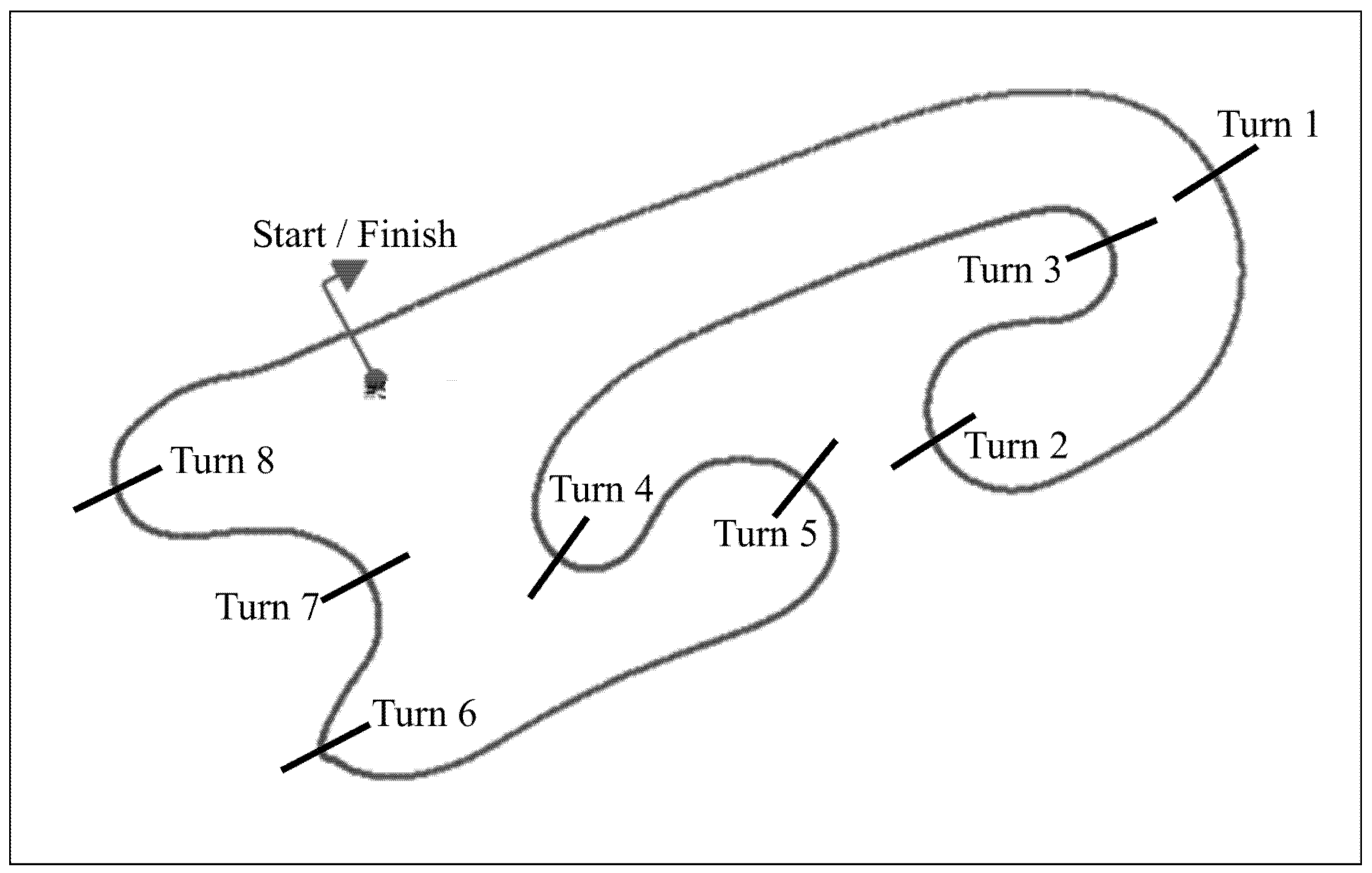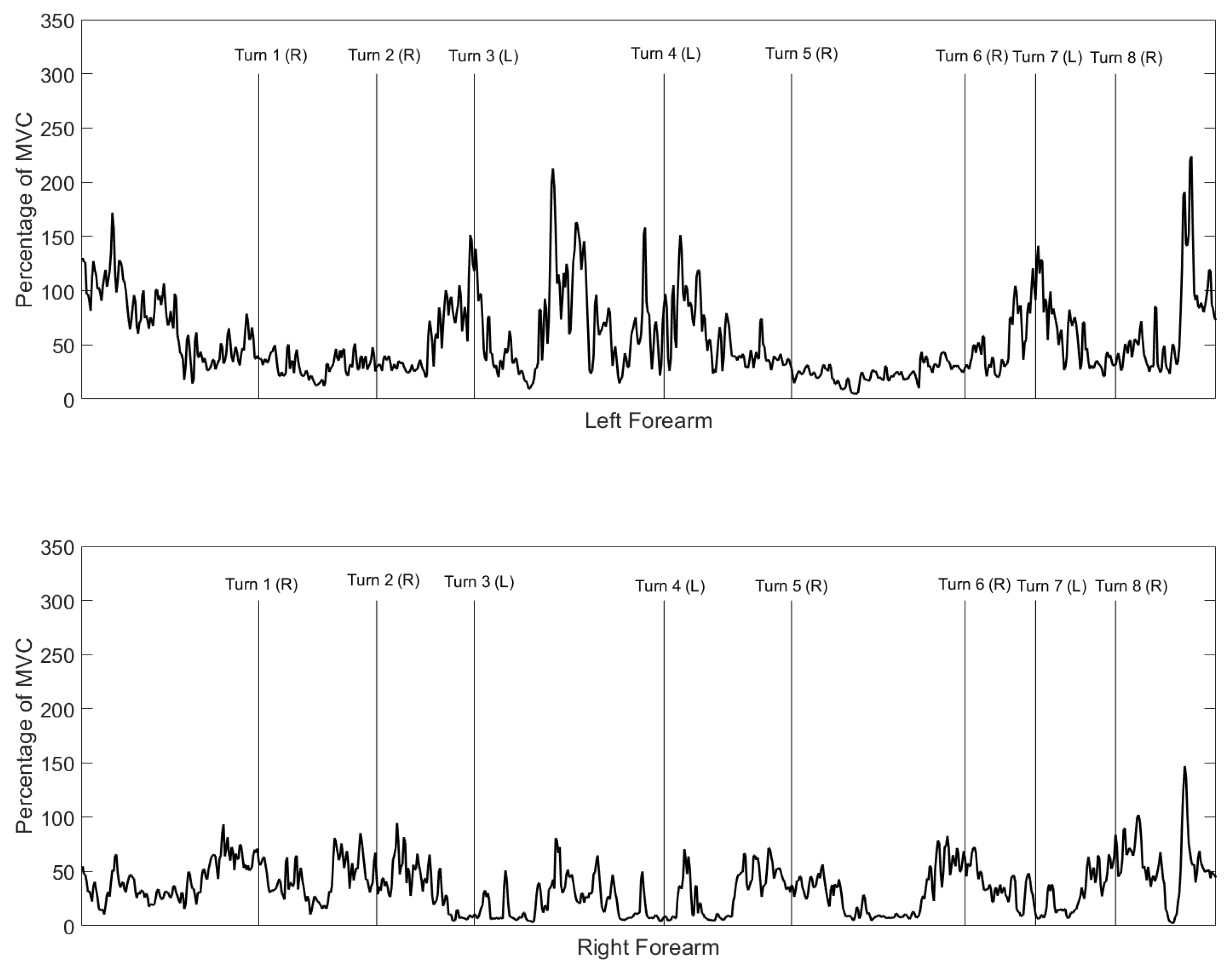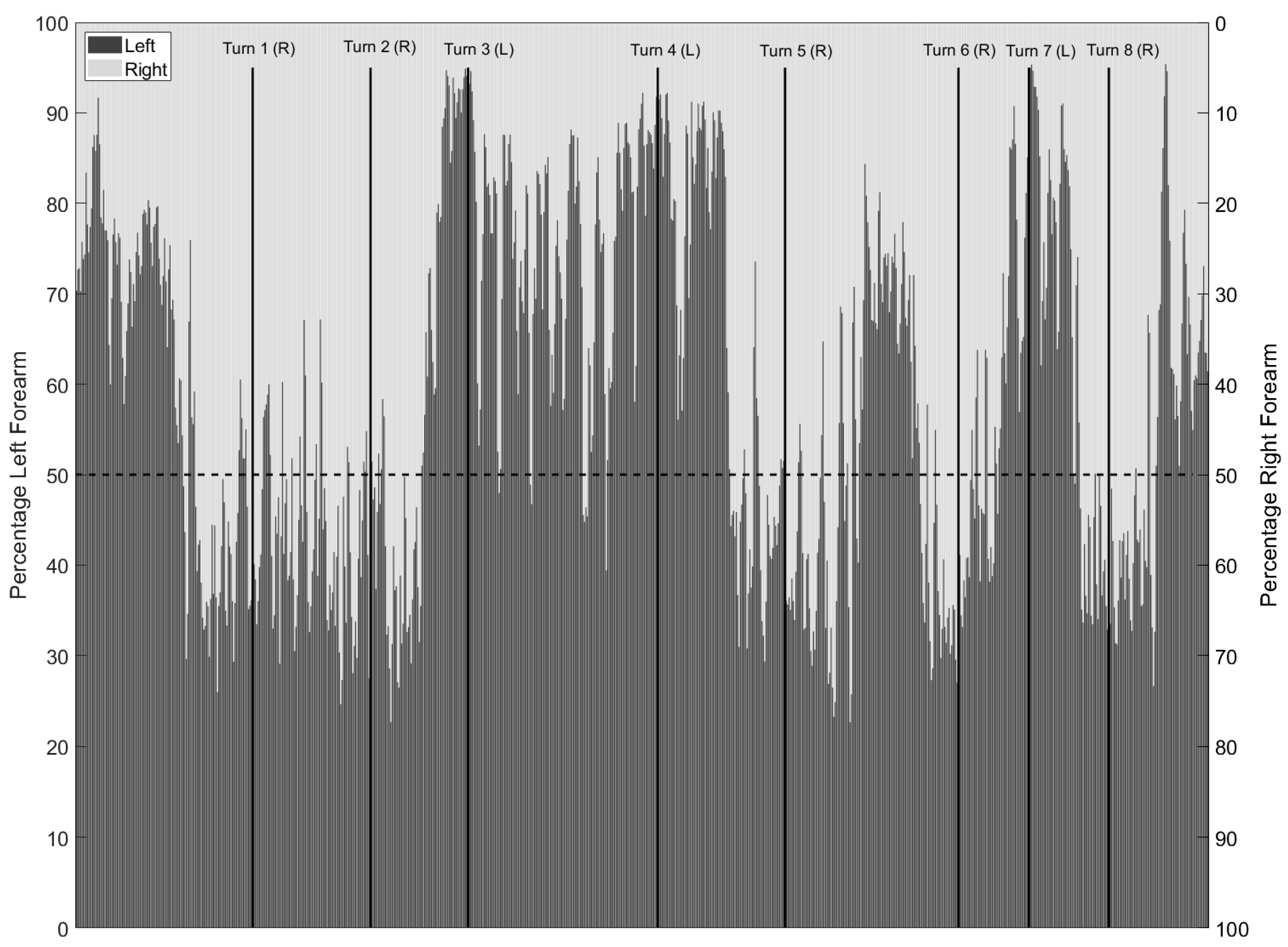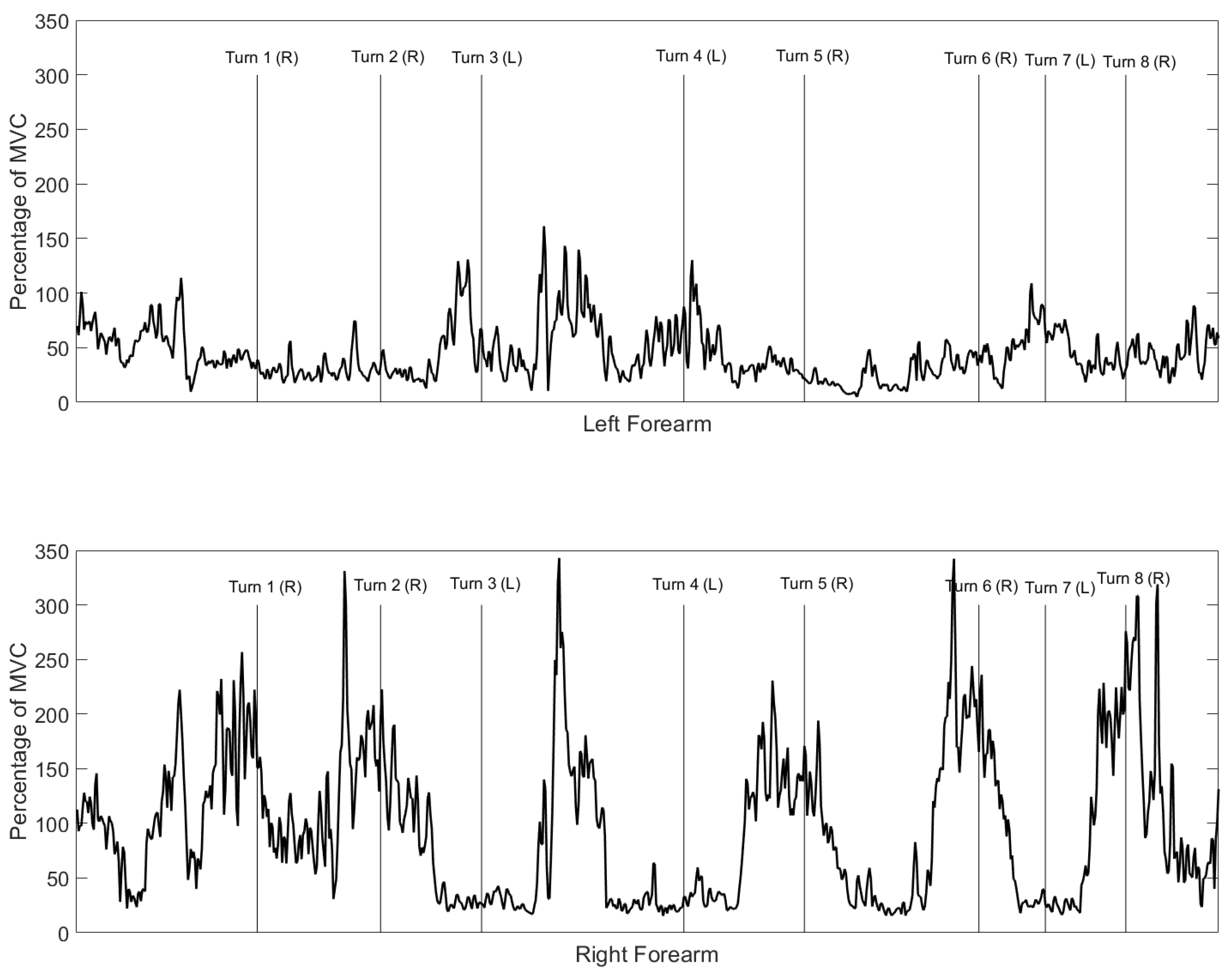1. Introduction
The physical demands of a racing car driver have been shown to reach levels similar to those of traditional (for example, basketball, football, and baseball) athletes [
1,
2]. Sustained heart rates of greater than 150 bpm [
3], combined with dehydration [
4], all act to increase the physical demands on the driver. The muscular efforts of braking and applying up to 61 kg to the brake pedal [
2] as well as steering [
5] and applying up to 16 kg of rotational ‘force’ to the steering wheel [
2] further add to the physical load and the psychological and emotional stress, placing extra demands on the driver, which all must be managed to maximise driver performance.
There is little empirical research on the muscle activity of racing drivers in situ. Several studies have demonstrated changes in muscular activation of the neck, shoulder and trunk muscles following adjustments to the driving position [
6,
7,
8] with improvements in lap times associated with adopting a right-arm-dominant steering action and showing that electromyography used to guide optimisation of seat fit can affect neuromuscular processes underlying the steering behaviour of the drivers in an SCCA-modified Porsche 944 s and a race-prepared Honda S2000. While these studies used different vehicle configurations, their findings conceptually support the idea that neuromuscular feedback can influence performance. However, in karting, the muscular activity of both arms in karts without gears did not exhibit significant differences [
9], suggesting a symmetrical driving style, and the authors attributed this to a process of anticipation related to the direction of the corner, which prevails over the dominant arm of the drivers, as both hands maintain a constant grip on the steering wheel with no need for gear changes. However, [
10] found some significant interlimb differences in forearm EMG activity pre versus post karting race but questioned the clinical importance of these findings as the change was <3%. The remaining published research has been conducted using driving simulators with aspects of muscle control such as muscular co-contraction of the agonists and antagonists being reported as a control strategy when applying steering torque during dynamic steering manoeuvres [
5]. Although the literature on EMG activity in motorsport remains relatively sparse and predominantly descriptive, recent studies [
11,
12] have begun to explore forearm muscle activation in relation to cornering direction and track layout. These investigations suggest that muscular demands vary with driving dynamics, underscoring the need for more systematic and analytical research in this area.
In most forms of motorsport, cornering is critical for decreasing lap times. In karting (as well as other forms of motorsport), there is no power steering; therefore the drivers increase muscle activity with their forearms to grip the steering wheel [
9,
13]. Whilst handgrip force has been shown not to deteriorate during a 45 min karting race [
14], understanding and assessing the muscular inputs to the steering wheel may yield a novel insight into the optimisation of driving technique that could be implemented via driver feedback, between test sessions, to help reduce lap time.
This proof-of-concept case study is used to present preliminary findings associated with data-informed feedback to improve driving technique in a later test session. The study aimed to firstly quantify forearm muscle activity during the fastest lap of session one, secondly to provide data-driven feedback to the driver, and thirdly, to evaluate driver muscle activity and lap time during session two. The purpose of this case study was to understand if it is feasible to use data on the muscular activations of selected forearm muscles, provided as feedback to the driver, to improve driver performance and decrease lap time. We hypothesised that EMG-informed feedback would enable an alteration in driver steering technique, reflected by modified muscular activation patterns and a reduction in lap time.
2. Materials and Methods
2.1. Participants and Protocol
Prior to data collection, ethical approval was gained from the University Research Ethics Committee. Given the novel nature of in situ EMG feedback, a single-case design was used as a proof-of-concept demonstration to understand the feasibility of this methodological approach. The participant provided informed consent prior to their data being collected. One ex-professional European karting driver (aged: 44 years, height 1.84 m), with no known injuries and not currently competing in karting, was recruited for this study. A customised 20 Hz Global Positioning System (GPS) (Race Technologies DL1 Club, Race Technologies, Nottingham, UK) was mounted on the Kart (SODI RT8 390cc Prokart, Daytona Karting, Esher, UK). Two surface electromyography (sEMG) sensors (Delsys, Trigno IM, Boston, MA, USA) were attached to the left and right flexor digitorum superficialis (essential for gripping), adhering to the SENIAM guidelines, and sampled at 1111 Hz. EMG sensors were secured using medical-grade adhesive tape and covered with sweat-resistant tape. Sensors were visually inspected post-recording to ensure no movement had occurred. A portable data logger (Trigno Personal Monitor, Delsys, Manchester, UK) was used to record and store the sEMG data whilst in the pits and on the race track.
Using a grip dynamometer (Takei, 5001, Birmingham, UK), left- and right-hand 5 s uni-lateral grip strength maximum voluntary contraction (MVC) tests were performed whilst sEMG data were recorded, prior to the driver getting into the kart before each session. The driver was then asked to get into the kart, and the GPS and sEMG system were set to record data. Both systems collected data simultaneously and were synchronised using an event marker pulse from a customised remote control to the analogue input ports of both systems. The driver was asked to complete 19 laps of the 900 m flat Daytona Karting circuit (Esher, UK) (
Figure 1), during the first test session. Upon completion of session one, the driver’s GPS and sEMG data were processed and fed back to the driver and the driver was asked to attempt to implement the feedback and complete a further 20 laps during the second test session. The kart setup, track and environmental conditions were similar between test sessions (dry track; light wind; ambient temperature 22°), and there were few other karts on the circuit, posing no impediment to lap times. Although exact control of vehicle dynamics and fatigue was not feasible, care was taken to ensure consistent environmental and mechanical conditions between sessions. The driver also conducted a similar self-selected warm up before each testing session.
2.2. Data Processing and Analysis
The GPS data were downloaded using Race Technology Limited (Nottingham, UK) software (version 8.5) and interpolated to 100 Hz using the in-built functions that fused GPS with onboard accelerometer data. The start/finish line and the apex of each of the eight corners (turns) were marked on the GPS data (
Figure 1) using a satellite image overlay. The interpolated GPS data for the fastest lap of session one were exported into MatLab (version 2018b) for further analysis. The sEMG data were downloaded to Delsys EMGworks (version 4.5.4) and cropped to align the start of the sEMG data with the start of the GPS data (using the event marker). The sEMG data were processed by firstly removing the mean, then secondly by using the amplitude analysis function to normalise the sEMG collected during driving to that of the MVC for each muscle, recorded prior to the testing session. The sEMG data were processed within this function using a Root Mean Square (RMS) calculation, with a window length of 0.1250 s and a window overlap of 0.0625 s. The normalised sEMG data corresponding to the fastest lap in session one were identified, exported to MatLab and used for further analysis.
Figure 1.
GPS data of track layout including start/finish line and corner apexes.
Figure 1.
GPS data of track layout including start/finish line and corner apexes.
The GPS and sEMG data for the fastest lap during session one was combined to display a figure (for driver feedback purposes) representing the amount of muscle activity across the fastest lap with left and right corners overlaid. The relative amount of muscle activity (left to right forearm) was also expressed as a percentage of MVC (measure prior to start of each session) to illustrate their relative contributions during each sector of the lap. These data were qualitatively fed back to the driver with supporting comments from the researcher to help data interpretation and advice (detailed in the Results Section) provided on how driver performance may be improved. Following session two, the GPS and sEMG were processed using the same procedure. Given the exploratory nature of this single-subject study, statistical testing was not performed; descriptive comparisons were used to identify meaningful patterns.
4. Discussion
This proof-of-concept case study sought to understand if data on the muscular activity of selected forearm muscles, provided as feedback to the driver, could be utilised to improve driver performance and decrease lap time in a subsequent test session. Therefore, this study adds a novel contribution by capturing and analysing muscle activation in real time during actual karting performance, offering insights into the demands of racing as they occur. This study aimed to firstly quantify forearm muscle activity during the fastest lap of session one (simulated qualification lap), secondly to provide feedback to the driver, and thirdly to evaluate driver muscle activity for the fastest lap during session two. Results demonstrated that the driver utilised an asymmetrical driving style with greater muscle activity within the left forearm during the fastest lap in session 1. Following the presentation of the muscle activity results and feedback to the driver, the driver was able to increase the muscle activity in their right forearm at key instances in the fastest lap of session 2, decreasing their lap time by 0.39 s, thus accepting the hypothesis. Thus, this suggests that it is possible to utilise muscle activity data during racing laps (in situ) to inform driver-specific feedback to alter muscular contributions during specific corners or where muscular asymmetries were present and consequently decrease lap time, whilst maintaining the same racing line around the track.
Examining the muscle activity data from session 1 showed greater left forearm peak muscle activity (~150% MVC) around the times of turns 3, 4 and 7 (left) compared to turns 1, 2, 5, 6 and 8 (right), suggesting the left forearm was contributing to a greater extent during left-hand corners (
Figure 2) than right-hand corners, whilst the right forearm muscular activity remained at approximately 50% of MVC throughout the lap without the change in magnitude shown in the muscle activity within the left forearm (
Figure 2). The relative left to right forearm percentage contributions (
Figure 3) also suggest the predominant use of the left forearm (~95% left, ~5% right) during left-hand turns, with only approximately 60% of the right forearm (40% left forearm) during the right-hand turns. This also suggests the left forearm was contributing more to the steering input than the right forearm. Given that previous research in karting has suggested that the muscular activity of both arms did not exhibit significant differences [
9], this highlighted a possible area for improvement.
The study results have demonstrated that muscular activity data-informed feedback can enable driver technique adjustments on the track. Exploring the muscle activity data from session 2 suggested that the timing and magnitude of muscular activity in the left forearm was similar to that during session 1. There was greater left forearm peak muscle activity (~140% MVC) around the times of turns 3, 4 and 7 (left) compared to turns 1, 2, 5, 6 and 8 (right), suggesting the left forearm was contributing to a greater extent during left-hand corners (
Figure 4) than right-hand corners. A dramatic change in muscular activity within the right forearm was evident following the feedback intervention. Peak muscular activity had increased from approximately 50% of MVC in session 1 to approximately 300% of MVC in session 2, with notable increases during the preparation for and exit of the right-hand corners (
Figure 4). The relative left to right forearm percentage contributions (
Figure 5) suggested an improved symmetry, with approximately 80% left forearm (20% right) during left-hand turns and 80% right forearm (20% left) during the right-hand turns (
Figure 5). These changes may have contributed to the 0.39 s improvement in lap time following feedback and were consistent with [
8], who also found improvements in lap times associated with adopting a right-arm-dominant steering action. A reduction of 0.39 s constitutes a meaningful performance difference; for context, at the British Universities Karting Championship (BUKC) Drivers Championship 2025, the fastest laps were separated by ~0.15 s across the four heats, and within Heat 3, the second- and third-placed drivers were split by 0.228 s [
15]. Whilst results did not show overall right arm dominance, the increased right forearm muscular activity improved symmetry [
9] and may have contributed to the improved lap time.
Whilst peak muscle activity was increased (up to 300%) in the right forearm, this increase may be unsustainable over a race duration and possibly more appropriate for a qualifying style lap. The possible onset of localised muscular fatigue, possibly utilising this muscular activity time history, may hinder driver performance [
7,
16]. Future work could aim to investigate localised muscular fatigue, particularly in longer endurance races to possibly inform performance outcomes or safety considerations related to muscular fatigue during driving in motorsport.
While performance improvements may stem from feedback-driven changes, we cannot exclude the potential influence of learning or familiarisation effects. Such high levels of muscular engagement may not be sustainable across long durations and could contribute to localised fatigue, particularly in endurance racing scenarios. The quantification of muscle activity in a case study should be interpreted with caution and serves here as an initial step toward broader validation. Whilst this study is limited by its single-subject design, lack of statistical testing, and the absence of a control condition, it does demonstrate the feasibility of this approach to be used in motorsport, and future work should recruit larger samples and explore feedback vs. non-feedback conditions to evaluate efficacy more robustly.










